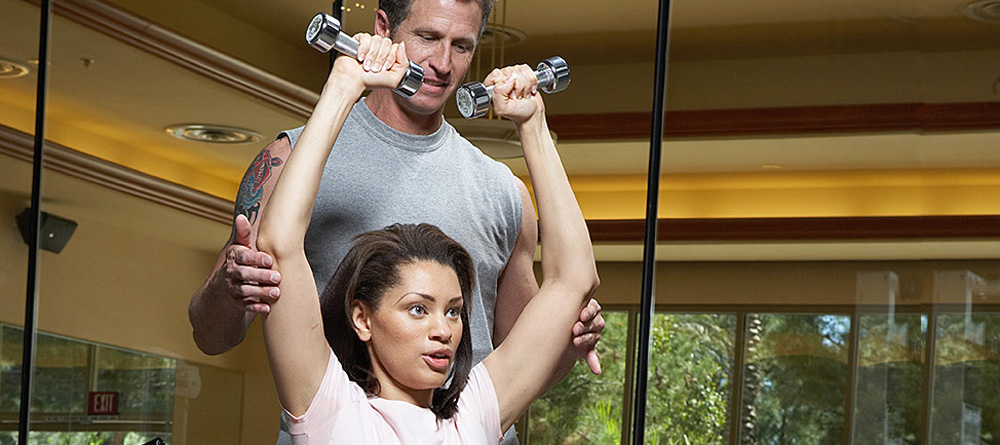Self-doubt swam through my mind as I climbed the steps to the workout floor of my local fitness center. Would I be able to handle this? Could I do it? Would I throw up? After spending the summer dealing with an ankle injury, surgery to fix it and then recovery, I honestly felt like a slug. I knew it was time to exercise regularly, but I was afraid to do it on my own and re-injure myself. During a brave moment, I casually mentioned to my husband, Bill, that I was interested in receiving personal training sessions for my birthday in September. Being the smart man that he is, he instantly realized he needed to guard his words. He was literally frozen in disbelief as he pondered and tried to clarify how serious I was about this personal training idea.
Eventually the day arrived when I met Jon, my personal trainer. I had strong doubts regarding the success of our relationship. He was a competitive, twenty-something year-old weightlifter while I was an out-of-shape homeschooling mom with eight children. Earlier that week, while talking with his supervisor to combat my apprehension, he assured me Jon would be the right fit.
Working with Jon over the course of several months taught me a great deal about healthy living, exercise and nutrition. What I didn’t expect was what he taught me about homeschooling. Here are ten of his tips—with a homeschooling twist:
1. Allow for days off: The first thing Jon did was ask me what day I would most definitely not be going to the gym. I easily rattled off an answer to this query. He followed this by asking for a second day when gym exercise wouldn’t happen. I had no problem answering this question either. He drew a schedule for the week and promptly marked in the two days I wouldn’t be coming to the gym. Then he wanted to know what I could do instead. Now I had to think. What would I do when I wasn’t at the gym? Could I incorporate a different type of exercising into my life?
Take the time to plan for days when you won’t be doing school. Your children will still be learning; it just won’t be book work. Maybe you enjoy spending birthdays together as a family. What about holidays? Do you need extra time to prepare for an event? Would you like a longer vacation? Plan now and enjoy that time away from the books doing lifestyle learning.
2. Do what you like to do: Jon encouraged me to choose activities at the gym I enjoyed doing. He told me it would be nearly impossible to commit to something I detested. I was glad to take swimming and cycling classes off of my list.
Choose a curriculum you enjoy and preferably one your children enjoy as well. If you don’t like it, the likelihood of your using it on a regular basis greatly diminishes. Do you prefer curriculum that is a straight-forward textbook approach, literature-based, a unit study or something else? There’s not a right answer to this question. Choices abound for curriculum options!
3. Make a plan: Jon wrote out a weekly schedule that included all of my training activities.
For homeschooling, I use a planner in which I write the material and assignments my children will be working on over the course of the week. In addition to this information, I also add a weekly menu, appointments, field trips and a running list of needed science supplies.
4. Assess the current situation: After we made a plan for when I wasn’t going to exercise and what I would do when I did exercise, we headed toward the human performance laboratory where I was weighed, measured and given a fitness test. By learning my starting point, I would be able to see the progress I made.
Likewise, with your students, assess the situation. Know your children’s strengths as well as areas which need improvement. Everyone starts somewhere. It’s where we go from there that’s important.
5. Set S.M.A.R.T. goals: Next, we determined reasonable long and short-term goals for my fitness. My bigger goal was to run a 5k race in March. Smaller goals included number of times going to the gym each week, amount of weight I would lift and classes I would attend. The goals we set were S.M.A.R.T.—Specific, Measurable, Achievable, Realistic and Time-Bound.
Maybe this is the year your child learns those multiplication facts, develops a mastery level in keyboarding, reads a certain number of books or actually publishes a self-written book. No matter what the subject, set some goals so you will all know where you are going and when you’ve arrived.
6. Prepare for setbacks: We discussed things that would prohibit me from coming to the gym. Some of my suggestions for excuses included: appointments, bad weather, sick children or just plain laziness. He gave me alternatives to try at home in case I didn’t make it in. He told me if all else failed, to come to the gym the following day and to not stress myself out about missing a day.
The same thing applies to homeschooling. There will be days when nothing goes right. My beautifully-written lesson plans don’t match those days when none of us feel like doing school, the dog has to go to the vet, the washing machine breaks or I’m sick. It will happen. Plan for educational activities your children can do without your help—a movie you find on a historical event, a craft to make, a story to write. Our children are capable of learning a great deal without our direct, every minute of every day, instruction.
7. Balance is critical: Jon taught me regularly about cardiovascular fitness, flexibility, strength, and nutrition. If I had my choice, I would do cardio every day. I love watching the numbers change on the machines and calculating the calories I’m burning. I set mini-challenges up for myself as I tried to beat my past records.
In homeschooling, I’m great at teaching some subjects. Sometimes it’s because they’re easy for me to teach; other times it’s because my curriculum is easier to use. At any rate, I need to utilize balance and teach multiple subjects—not just those that are our favorites for one reason or another.
8. Small improvements add up: Jon had me bring in a notebook. Every time we trained together he wrote down the workout along with my statistics like weight, repetitions or distance. As I exercised over the months, it was gratifying to see the documented improvement. He told me even if I made only a one percent improvement each week, over time all those one percents would add up. My perfectionistic self had never looked at it that way.
Throw away your desire for perfectionism and realize that little by little, bit by bit, your children will make progress that adds up at the end of the year. Look back at what you taught last year. Save past work so you and your children can see how far you’ve all come.
9. Consistency is the name of the game: It didn’t matter if I went to the gym all day every Monday. If I didn’t go the rest of the week, I would never see the type of results I was after. Cold, rainy days and those mornings I didn’t want to get out of bed, let alone go to the gym, didn’t deter me from going to the gym. Sometimes I had to remind myself to think about how I felt when I walked out of the gym knowing I had accomplished yet another step toward my goals.
There are many days I don’t feel like homeschooling. I can guarantee my children also experience that same struggle. Yet, we march on. We know this is a path we are called to travel. Some days the scenery is beautiful; the day is sunny, and everything goes right. Some days we head down that same path knowing we are continuing to get to our destination.
10. Celebrate success! After working hard all week, it was a wonderful privilege to enjoy date night with a restaurant splurge, purchase a new item of clothing or even save up for a massage. In addition, the comments of encouragement from my friends and family definitely boosted my motivation to continue to work hard.
Celebrate your children’s success! We encouraged one child to learn to read by promising a giant Lego prize at the finish line. We’ve gone skating, cooked creations, played with friends and a myriad of other things. Take the time to celebrate both for them and for you. You all deserve it!




